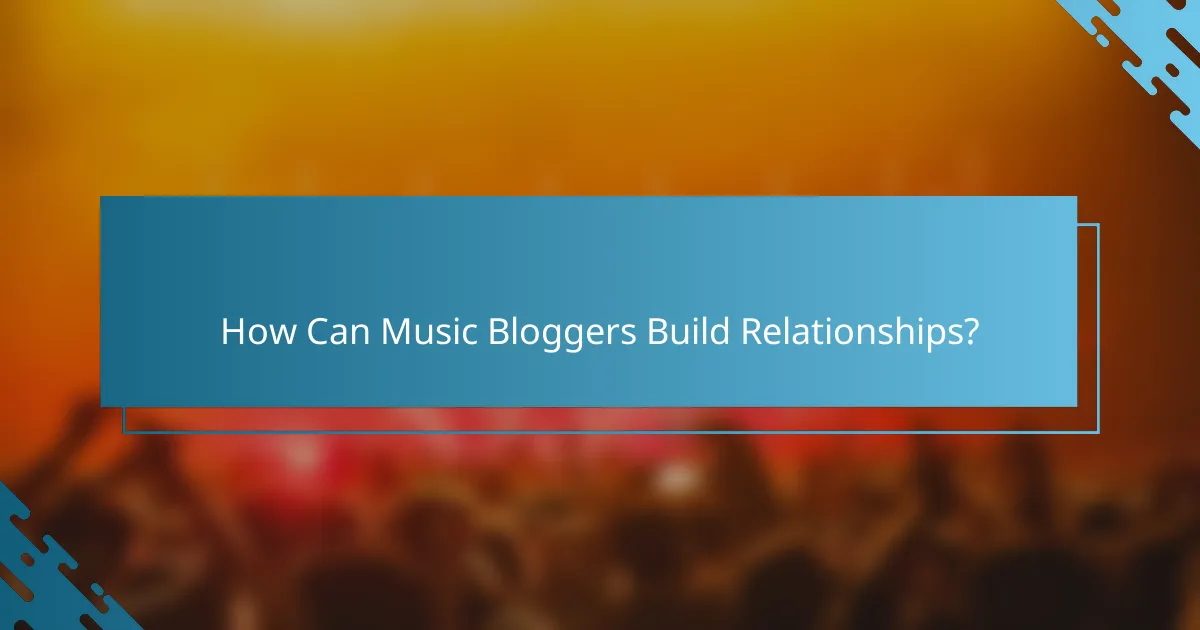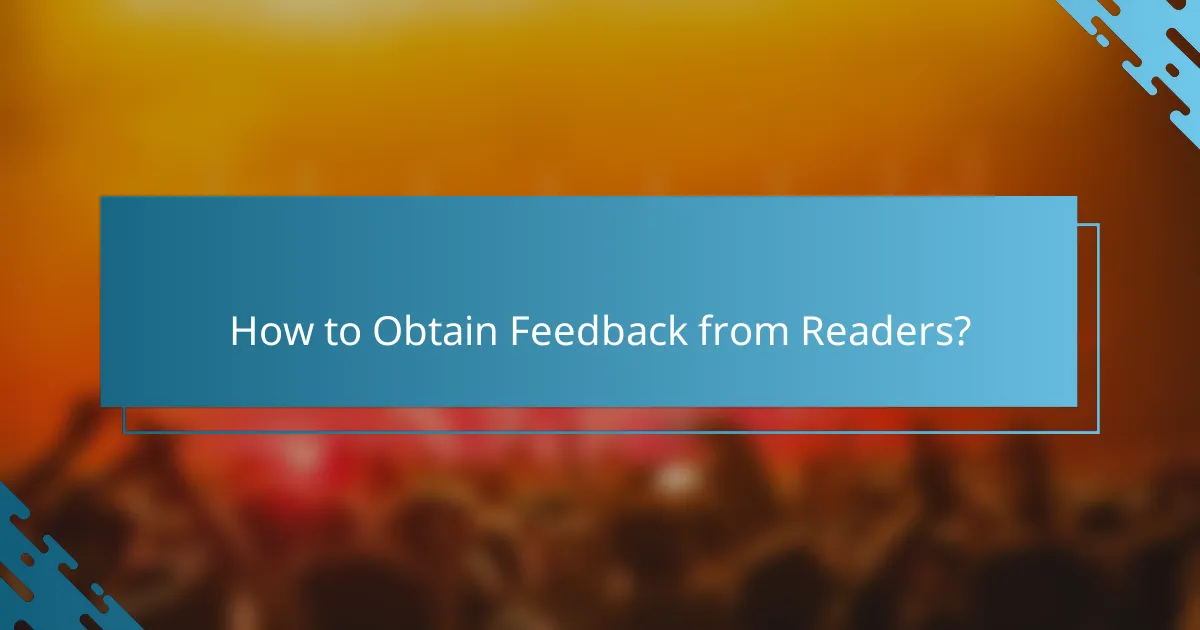Music bloggers play a crucial role in the industry by building relationships with artists and the music community, which enhances collaboration and exposure. By employing effective strategies such as SEO, social media engagement, and content sharing, bloggers can significantly increase their visibility. Additionally, seeking feedback from readers fosters deeper connections and provides valuable insights into audience preferences.

How Can Music Bloggers Build Relationships?
Music bloggers can build relationships by actively engaging with artists, other bloggers, and the broader music community. Establishing these connections fosters collaboration, enhances exposure, and opens avenues for valuable feedback.
Networking with artists
Networking with artists is essential for music bloggers to gain insights and exclusive content. Attend local gigs or online performances to meet musicians personally, and consider reaching out via email or social media to express your interest in their work.
When connecting with artists, be genuine in your approach. Share your thoughts on their music and suggest ways you could collaborate, such as interviews or features on your blog.
Engaging with other bloggers
Engaging with fellow bloggers creates a supportive community where ideas and resources can be shared. Commenting on their posts, sharing their content, or collaborating on articles can strengthen these relationships.
Consider joining blogging networks or forums where music bloggers congregate. This can lead to partnerships that enhance your blog’s reach and credibility.
Participating in music events
Participating in music events, such as festivals or conferences, provides opportunities to meet industry professionals and fellow bloggers. These gatherings often feature panels and workshops that can enhance your knowledge and network.
Make it a goal to attend at least a few key events each year. Bring business cards and be prepared to discuss your blog and its focus with others you meet.
Utilizing social media platforms
Utilizing social media platforms is crucial for building relationships in the music blogging sphere. Engage with artists and other bloggers by sharing their work, commenting on posts, and participating in discussions.
Focus on platforms where your target audience is most active, such as Instagram, Twitter, or TikTok. Regularly post content that resonates with your followers to maintain visibility and encourage interaction.
Collaborating on projects
Collaborating on projects with artists or other bloggers can lead to mutually beneficial outcomes. Consider co-hosting a podcast, creating a joint playlist, or writing guest posts to leverage each other’s audiences.
When proposing collaborations, be clear about the benefits for both parties. This approach can lead to increased exposure and a richer content experience for your readers.

What Strategies Help Gain Exposure?
To gain exposure as a music blogger, focus on effective strategies that enhance visibility and audience engagement. These approaches include leveraging SEO techniques, utilizing music submission platforms, creating shareable content, building an email list, and using social media advertising.
Leveraging SEO techniques
SEO techniques are essential for increasing your blog’s visibility in search engine results. Start by researching relevant keywords related to your niche and incorporating them naturally into your content, titles, and meta descriptions.
Consider optimizing images with alt text and ensuring your site is mobile-friendly. Regularly updating content and building backlinks from reputable sites can also improve your search rankings.
Utilizing music submission platforms
Music submission platforms allow bloggers to connect with artists and receive new music for review. Sites like SubmitHub or ReverbNation can help you discover emerging talent while providing artists a way to reach your audience.
When using these platforms, be clear about your blog’s focus and audience to attract submissions that align with your content. This targeted approach can enhance your blog’s credibility and attract more visitors.
Creating shareable content
Creating shareable content is key to expanding your reach. Focus on producing high-quality articles, engaging videos, or infographics that resonate with your audience and encourage sharing on social media.
Consider incorporating lists, how-to guides, or interviews with artists, as these formats tend to perform well. Always include social sharing buttons to make it easy for readers to share your content.
Building an email list
An email list is a powerful tool for maintaining direct communication with your audience. Offer incentives like exclusive content or free downloads to encourage sign-ups on your blog.
Regularly send newsletters featuring your latest posts, music recommendations, or industry news. This keeps your audience engaged and increases the chances of them sharing your content with others.
Using social media advertising
Social media advertising can significantly boost your blog’s exposure. Platforms like Facebook, Instagram, and Twitter offer targeted ad options that allow you to reach specific demographics interested in music.
Set a budget and experiment with different ad formats, such as sponsored posts or stories, to see what resonates best with your audience. Monitor engagement metrics to refine your strategy and maximize your return on investment.

How to Obtain Feedback from Readers?
To obtain feedback from readers, actively seek their opinions through various channels. Engaging your audience not only enhances relationships but also provides valuable insights into their preferences and experiences.
Encouraging comments and discussions
Encouraging comments and discussions on your blog can create a sense of community among readers. Ask open-ended questions at the end of your posts to invite responses and foster dialogue. Regularly responding to comments can also stimulate further interaction.
Consider hosting discussion threads on specific topics related to your content. This can lead to deeper engagement and provide you with diverse perspectives that can inform your future posts.
Conducting surveys and polls
Surveys and polls are effective tools for obtaining structured feedback from your audience. Use platforms like Google Forms or SurveyMonkey to create simple surveys that ask about readers’ preferences, interests, and satisfaction with your content.
Keep surveys concise, ideally under 10 questions, to encourage participation. You can share these surveys via email or social media, ensuring they reach a broad audience.
Offering incentives for feedback
Offering incentives can motivate readers to provide feedback. Consider running contests or giveaways where participants can win prizes for completing surveys or leaving comments. This not only boosts engagement but also increases the likelihood of receiving valuable insights.
Ensure that the incentives are relevant to your audience, such as music-related merchandise or exclusive content access, to maximize participation rates.
Engaging in direct outreach
Direct outreach involves personally contacting readers for their feedback. This could be through emails or social media messages, where you ask specific questions about their experiences with your blog.
Personalized messages can make readers feel valued and more inclined to share their thoughts. Be sure to follow up with those who respond, showing appreciation for their input.
Analyzing website analytics
Website analytics provide quantitative data about reader behavior, which can inform your content strategy. Tools like Google Analytics can show you which posts attract the most traffic and where readers drop off, indicating areas for improvement.
Look for trends in page views, average time spent on pages, and bounce rates. This data can guide you in tailoring your content to better meet the interests of your audience, ultimately enhancing engagement and feedback opportunities.

What Are the Best Tools for Music Bloggers?
The best tools for music bloggers enhance content creation, design, marketing, and social media management. Utilizing the right platforms can streamline your workflow and increase your audience engagement.
WordPress for blogging
WordPress is a leading platform for music bloggers, offering customizable themes and plugins tailored for music content. It allows you to create a professional-looking website with ease, enabling features like audio players, galleries, and event calendars.
Consider using plugins like Yoast SEO to optimize your posts for search engines, which can help increase visibility. Regularly updating your content and engaging with your audience through comments can foster a loyal following.
Canva for graphic design
Canva is an accessible graphic design tool that helps music bloggers create eye-catching visuals for their posts and social media. With a wide range of templates, you can design album covers, promotional graphics, and infographics without needing advanced design skills.
Utilize Canva’s drag-and-drop interface to customize your designs quickly. Keep your branding consistent by using similar colors and fonts across all your graphics to strengthen your identity.
Mailchimp for email marketing
Mailchimp is a powerful email marketing platform that allows music bloggers to build and manage mailing lists effectively. You can create newsletters to share updates, new posts, and exclusive content with your subscribers, helping to maintain engagement.
Segment your audience based on their interests to send targeted emails, which can improve open rates. Regularly analyze your campaign performance to refine your strategies and increase subscriber interaction.
Hootsuite for social media management
Hootsuite is a comprehensive social media management tool that enables music bloggers to schedule posts across various platforms. This helps maintain a consistent online presence without needing to be online constantly.
Use Hootsuite’s analytics features to track engagement and adjust your content strategy accordingly. Setting up streams for monitoring mentions and relevant hashtags can help you stay connected with your audience and industry trends.
